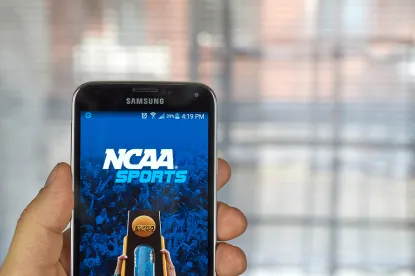We previously wrote about California Senate Bill 206, the “Fair Pay to Play Act,” back in April, and now Gov. Gavin Newsom has signed that bill into law.[1] The law becomes effective on January 1, 2023. After numerous revisions to the bill since our last post, here is a quick look at the final product.
The new Fair Pay to Play Act allows California student-athletes to earn compensation from licensing their name and image and to obtain professional representation by lawyers and agents to assist with that effort, all without losing scholarship eligibility or amateur status under the National Collegiate Athletics Association’s (NCAA) Division I and II eligibility criteria. Importantly, the law specifically prohibits colleges, athletic associations and intercollegiate conferences from paying such compensation to prospective student-athletes.
Of particular significance are Sections 1(a) and 1(b) of the new law, which foreshadow further legislative changes based on recommendations from the NCAA “working group” created in May 2019. The working group was established to examine the impact of permitting commercial use of a college student-athlete’s publicity rights, so that the California legislature can “ensure appropriate protections are in place to avoid exploitation of student athletes, colleges, and universities.”[2] We anticipate the NCAA will have much to say on that topic given its staunch resistance to the new law, so future legislative changes could impact the practical value of the opportunities for brands that are banking on this new pool of potential influencers and brand ambassadors.
Another issue that must be resolved early is the perceived inequity this law creates among NCAA Division I and II programs. As California institutions will now have a unique premium appeal to prospective student-athletes looking to tap into the new revenue stream, the remaining 612 NCAA Division I and II athletic programs are left with nothing comparable to offer. Indeed, this inequity has already led to similar laws being introduced in other states. In addition, the NCAA has plenty of time to develop further administrative regulation that would severely limit the opportunities the Fair Pay to Play Act seemingly creates. Note however, under the new law, the NCAA may not prevent California colleges from participating in intercollegiate athletics as a result of a student-athlete receiving compensation for her publicity rights. It will be interesting to see how the NCAA responds to this law outside California.
On the other side, brands and ad agencies have their own set of considerations before baking new collegiate athlete publicity campaigns into their 2023 marketing budgets. For example:
-
Cost. The Fair Pay to Play Act opens the door for brands to partner with student-athletes, but also permits student-athletes to be represented by attorneys or agents, making negotiations more sophisticated, lengthy and costly. These expenses are a gamble given the uncertainties in how the new law will be interpreted and enforced.
-
Conflict. Student-athletes have obligations to their academics, team and coaches that could prohibit or restrict a meaningful ability to commercialize their publicity rights.
-
Compliance. Brands must stay current on new restrictions introduced at the college or NCAA level through administrative regulations and private contracts, which may prohibit or restrict certain activities and make the resulting publicity rights less valuable.
-
Collaboration. The use of collegiate sports mascots, logos and other branding elements as part of a student-athlete publicity campaign could amplify the ROI for brand partners. However, colleges are historically selective in licensing out those brand elements, and such licenses typically contain category and geographic exclusivity provisions. Accordingly, brands should plan early and be prepared with appropriate licenses at the institution level to realize the most value from a promotional relationship with a particular student-athlete.
The new law is only the first quarter in a long game with many stakeholders, and discussions about the ramifications of the California Fair Pay to Play Act will continue to take center court. As a result, we expect major shifts in the collegiate sports legal and competitive landscape over the next three years. In fact, similar game plans to the Fair Pay to Play Act are already in motion, as Florida Representative Kionne McGhee-D filed HB-251[3] in the House of Representatives on September 30, which would allow Florida collegiate student-athletes to make commercial use of their own publicity rights. The proposed law would take effect on July 1, 2020.
At the federal level, U.S. Representative Anthony Gonzalez (R-Ohio), a former wide receiver for the Ohio State University Buckeyes, is already planning a bill to allow compensation to student-athletes in all states for licensing their publicity rights. This would be an interesting move by the federal government into the right of publicity space, since publicity and related privacy rights have historically been regulated by the individual states.
Here we go!
[1] https://leginfo.legislature.ca.gov/faces/billTextClient.xhtml?bill_id=201920200SB206
[2] California Senate Bill No. 206 § 1(b).
[3] https://www.myfloridahouse.gov/Sections/Bills/billsdetail.aspx?BillId=66760




 />i
/>i

